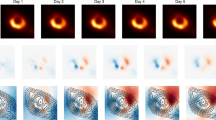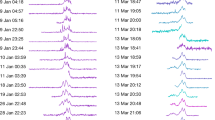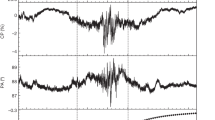Abstract
Time variations in compact extragalactic objects can be used to constrain both their emission mechanisms and models for their geometry. In particular, periodic variations constrain the popular black hole model for these sources1,2. There have been many reports of the presence (and absence) of both periodic3–8 and non-periodic9 variability in the BL Lacertae object OJ 287 = 0851 + 202, from the optical and infrared through centimetre radio wavelengths (Table 1). The apparent consistency of the reported periodicity near P =15.7 min and the absence of variations in other sources observed in the same way lends some credence to these variations, even though they are only a few per cent of the mean intensity. We observed OJ 287 with the Very Large Array (VLA) at 5, 15 and 22 GHz several times in early 1983. The 5-GHz data, taken coincident with the 22-GHz observations of Valtaoja et al.8, show OJ 287 to have decreased in flux by about 1.8% in an irregular way over a span of about 7 h, and to have fluctuated by about 0.5% on a timescale of about 15 min. Brightness temperatures derived from causality constraints range between 1016 and 1020 K. Fourier spectra of the time series were analysed using a novel one-dimensional complex CLEAN algorithm to remove the effects of the data sampling. At 5 GHz there was no harmonic component to the intensity of OJ 287 which exceeded 0.1% of the mean for any period between 80 and 5,000 s. The limits at 15 and 22 GHz were 2% and 0.8%, respectively.
This is a preview of subscription content, access via your institution
Access options
Subscribe to this journal
Receive 51 print issues and online access
$199.00 per year
only $3.90 per issue
Buy this article
- Purchase on Springer Link
- Instant access to full article PDF
Prices may be subject to local taxes which are calculated during checkout
Similar content being viewed by others
References
Abramowicz, M. A. & Nobili, L. Nature 300, 506–507 (1982).
Elliot, J. L. & Shapiro, S. L. Astrophys. J. 192, L3–L6 (1974).
Visvanathan, N. & Elliot, J. L. Astrophys. J. 179, 721–730 (1973).
Frolich, A., Goldsmith, S. & Weistrop, D. Mon. Not. R. astr. Soc. 168, 417–425 (1974).
Kiplinger, A. J. Astrophys. J. 191, L109–L110 (1974).
Carrasco, L., Dultzin-Hacyan, D. & Cruz-Gonzalez, I. Nature 314, 146–148 (1985).
Valtaoja, E. et al. Nature 314, 148–149 (1985).
Valtaoja, E. et al. Univ. Turku Rep. Ser. TURKU-FTL-R 26 (1982).
Wolstencroft, R. D., Gilmore, G. & Williams, P. M. Mon. Not. R. astr. Soc. 201, 479–485 (1982).
Napier, P. J. & Crane, P. C. Aperture Synthesis Workshop (eds Thompson, A. R. & D'Addario, L. R.) Ch. 3 (National Radio Astronomy Observatory, Green Bank, 1982).
Crane, R. K. in Methods of Experimental Physics Vol. 12B (ed. Mees, M. L.) 178 (Academic, New York, 1976).
Hogbom, J. A. Astr. Astrophy. Suppl. 15, 417–426 (1974).
Lehár, J. thesis, Brandeis Univ. (1985).
Author information
Authors and Affiliations
Rights and permissions
About this article
Cite this article
Dreher, J., Roberts, D. & Lehár, J. Very Large Array observations of rapid non-periodic variations in OJ 287. Nature 320, 239–242 (1986). https://doi.org/10.1038/320239a0
Received:
Accepted:
Issue Date:
DOI: https://doi.org/10.1038/320239a0
This article is cited by
-
Study of Rapid Variability of the Blazar OJ 287 in the Radio and Optical Ranges
Astrophysics (2020)
-
On the variability timescales and magnetic field in OJ 287
Astrophysics and Space Science (1996)
-
Rapid variability of extragalactic radio sources
Nature (1989)
-
A possible 35-minute periodicity in the OJ 287 active galactic nucleus at 7-mm wavelength
Nature (1988)
Comments
By submitting a comment you agree to abide by our Terms and Community Guidelines. If you find something abusive or that does not comply with our terms or guidelines please flag it as inappropriate.



